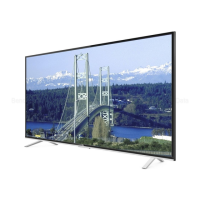
Do you have a question about the TCL U55S6806S and is the answer not in the manual?
General safety measures, including ventilation, heat, moisture, and fire prevention.
Critical warnings about domestic use, cable safety, liquids, fire, and headphone volume.
Details on the TV screen material, pixel behavior, and cleaning procedures.
Safety advice and procedures for securely hanging the TV on a wall.
Guidelines for environmentally responsible disposal of electronic equipment and batteries.
Statement of TV compliance with European directives and standards.
Instructions for connecting the power cord and antenna to the TV.
Guide to connecting DVD players, home theatre systems, and similar equipment.
Instructions for connecting recorders, receivers, game consoles, camcorders, and headphones.
Important advice on connector types, USB usage, MHL, ARC, and cable quality.
Detailed explanation of remote control buttons and their functions for TV operations.
Key information regarding battery care and using TV set buttons as remote alternatives.
Step-by-step guide for turning the TV on, entering standby, and disconnecting power.
Guide through the first-time setup process for language, country, and network.
Instructions for performing an automatic search to find available TV channels.
Detailed procedures for automatic channel tuning via Cable, Antenna, or Satellite.
Methods for changing channels and switching between different input sources.
Instructions for adjusting the TV's sound volume and using the mute function.
Steps to access and navigate the TV's main settings and submenu options.
Procedure to select and change the language for TV menus and on-screen information.
Guide to creating and managing a personalized list of favorite TV channels.
How to access and configure power-saving modes for reduced energy consumption.
Instructions and essential warnings for viewing 3D content, including glasses usage.
How to select the appropriate sound output format for connected audio devices via SPDIF.
How to enable and adjust audio description narration for visually impaired users.
Accessing information on signal strength and quality for digital TV channels.
How to use the Timeshift function to pause, record, and playback live TV programs.
How to enable, disable, and manage subtitles for different TV channels and broadcasts.
Selecting preferred subtitle languages and types, including hearing impaired options.
Information on accessing and using Teletext services, including language settings.
How to find and use the built-in electronic user manual for detailed instructions.
Setting up automatic clock synchronization and renaming input sources.
Methods for updating the TV's firmware via USB or a network connection.
How to switch between Home, Shop, or Shop with Demo display modes.
Information on using CI modules for accessing encrypted digital services and their installation.
Details on playing DivX files, registering the device, and managing DivX VOD.
Using T-Link for one-touch playback and standby control of connected HDMI devices.
Procedure to reset the TV to its original factory default settings.
How to view pictures, play music, and watch videos stored on USB storage devices.
Using specific browsers to access and manage different media file types from a USB drive.
Guide to navigating, selecting, and scheduling programs using the on-screen EPG.
Instructions for using the PVR function to record favorite TV programs onto a connected USB drive.
How to connect MHL-compatible mobile devices for charging, screen mirroring, and remote control.
How to access and use MHEG services for interactive digital text and features.
Overview of configuring wired or wireless network connections for Internet access.
Steps to establish a wired LAN connection using an Ethernet cable.
Procedures for connecting the TV to a wireless network using Wi-Fi.
How to set up DLNA for sharing and accessing media content from a PC.
Steps to connect a PC to the network and prepare it for media sharing with the TV.
How to use the DLNA application to view shared photos, music, and videos.
How to use GuideOn to access network-based Electronic Programme Guides.
Using a smartphone or tablet as a remote control via a dedicated application.
How to wirelessly share screen and audio from mobile devices to the TV.
Explanation and access methods for HbbTV, offering interactive internet content.
Steps to enable HbbTV for interactive services and how to turn it off.
Instructions on how to open the Smart TV interface to use internet applications.
Information on managing parental control PINs, including default and super passwords.
A guide to diagnosing and resolving common problems like no picture/sound or unclear image.
Details on TV broadcasting types, operating/storage conditions, and OSS notices.
Legal disclaimers regarding SmartTV services, content, and product compliance declarations.
Disclaimers on content usage, third-party services, and liability for interruptions or changes.
Statement of compliance with relevant directives and information on where to find the official declaration.
